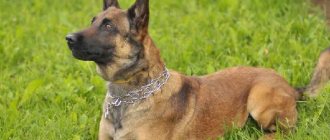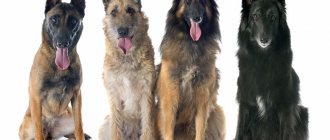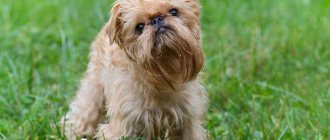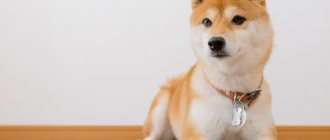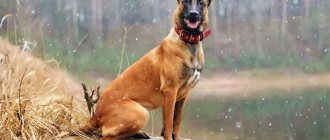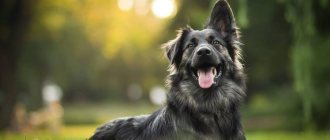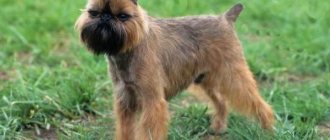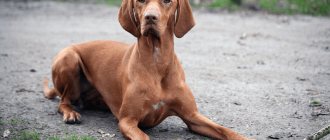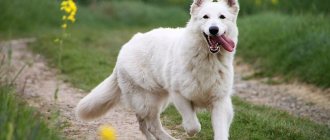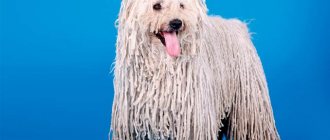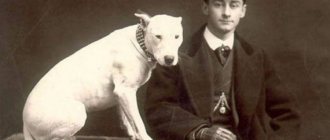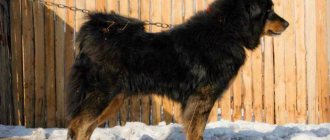Owners usually associate dogs with red coloring with the sun and warmth. Indeed, when exposed to sunlight, their fur emits light and shimmers with all sorts of reddish colors. Because of their cheerful coloring, they seem mischievous and playful. Therefore, many people choose a pet of this particular color.
In our material, we have prepared a description of the appearance and color features of the 20 most popular breeds of saffron dogs. We hope that the prepared article will help you choose a pet that will delight you for a long time.
American Staffordshire Terrier
These representatives of the canine world are considered a “thunderstorm” to strangers; they have a massive front part with a large head, a wide muzzle and a powerful jaw. There is a slight stiffness in movements due to the elongated hind legs, the front legs are spaced quite widely.
Cynologists allow almost all shades of “red” - from bright red to cream. Spotted dogs often have a combination of white and orange tones. Moreover, white spots should cover no more than 20% of the body. The fur is distinguished by its unique shine and thickness. It is hard to the touch and fits tightly to the body. Pets of a brick or black-and-red hue are considered a waste.
Personality of the Belgian Shepherd
The intelligence and intelligence of Belgian Shepherds can be complimented endlessly.
For these qualities, they are willingly recruited to serve in law enforcement and military agencies to perform difficult tasks that require endurance and intelligence.
They participate with honor in sports competitions, serve as guards and search dogs.
Photo 6. Belgian Shepherd puppies
“Belgians” have an excellent memory, allowing them to easily endure the hardships of training.
These dogs should feel the “strong hand” of the owner, but excessive rudeness during their upbringing is contraindicated, as it contributes to the development of cowardice and neurasthenia in them.
Belgian Shepherds cannot be called overly friendly, but they are also able to control their aggressiveness.
They are indifferent to strangers and strangers until they want to pet the dog or get too close to it.
The “Belgian” will definitely warn the ill-wisher with an angry growl, which will completely discourage anyone from encroaching on the dog’s freedom.
This is the beauty of Belgian Shepherds. Their purpose is to be a guard, to serve a person, to perform specific duties that indoor and pampered breeds are simply not capable of.
Pomeranian Spitz
The red color of this breed is widespread in Russia. Fluffy fur is characterized by both rich fox and light orange colors. Usually puppies are born lighter in color, and after a few months their little “fur coat” darkens.
The standard assumes the presence of fur of varying intensity on individual parts of the body: chest, muzzle, paws. If you want to buy a red pet, thoroughly check the pedigree and pay attention to the ears. They will remain the same after molting.
Akita Inu
It was the red-fawn dog that became popular all over the world thanks to the legendary film “Hachiko”. The canine community has recognized the red shade as the most common color for representatives of this breed.
The fur can be of any shade: from red-fiery to light beige. However, the shirt front, cheeks, bottom of the muzzle, belly, and inner parts of the legs must remain white. There may be light markings on the neck. Initially, the color of puppies is gray or black, and with age it becomes “red.”
Chow chow
The breed has an unusual appearance: a large collar of soft wool, a massive head with wrinkles, and a somewhat sad expression on the face.
As for the color, the red color with red tints is considered classic for the Chow Chow. Coat color varies from deep orange to light apricot. Moreover, the mane, part of the tail and fur in the area of the lower jaw should be much lighter than the rest of the body. Dark eyes, a large nose and a bluish tongue are the calling card of this dog. Initially red puppies are born brown and later become fiery red.
Belgian Shepherd care and maintenance
If you have a Belgian Shepherd, be prepared to follow certain hygiene rules. The coat is thick, coarse, and water-repellent. The undercoat is short and soft. Shedding is especially noticeable seasonally, 2 times a year from winter to summer.
During the molting period, brush your pet more often, this way you will remove dead hairs and the surface will become well-groomed.
It is important to remember that frequent bathing, even with the use of special shampoos for dogs, spoils the coat, subsequently leading to loss of dullness and stiffness. The peculiarity of wool is its lack of shine, softness and silkiness.
If the desire to bathe her and get rid of the dog smell is irresistible, then use only special products and in minimal quantities.
Belgian Shepherd breed photo on the grass
Dry brushing of the coat is necessary regularly. To do this, you will need a special comb with sparse teeth so that when combing you do not tear out pieces of fur. Comb only with slow movements. The brush chosen is not thick, but quite hard. It is recommended to brush an adult dog once a week, but for a puppy - twice a week.
Red Breton Griffon
An ancient hunting dog with a strong body and a large head. Representatives of this breed have a predominant orange color. All its varieties are considered the most preferable: from brick to wheat-golden. The presence of a light, uneven mark on the chest is relevant. There are small patches of black hair on the mask, in the area of the mustache, sideburns and beard. The mask of griffons can become almost invisible or simply more intensely red or red.
Belgian Shepherd character
Photo of a Belgian Shepherd (Tervuren) standing in the snow
The Belgian Shepherd is active and intelligent by nature, with excellent guarding qualities. Without an owner or shepherd, she is able to make decisions independently.
An attentive and independent animal, at the same time quite obedient, capable of following any commands. This is one of the most sensitive dogs reacting to any disapproval from the owner. In the absence of proper socialization and certain circumstances, the Belgian will grow up aggressive, or, conversely, shy and timid. With early socialization and proper training, he will grow into a balanced dog - he will be a companion, a guard, and just a wonderful friend.
The Belgian Shepherd can be owned by families with children. However, they are not particularly playful with children, but are completely submissive to them. They often become attached to one person, but they will not refuse attention from other family members.
It is worth remembering that the Belgian Shepherd has a well-developed protective instinct; be careful when introducing the dog to new people.
To get used to getting along with other pets, you will have to put in a lot of time and effort. They love to chase cats. Due to their high intelligence and desire to learn, they are easy to train.
Hungarian Vizsla
The name of this breed is translated from Hungarian as “to search”, so it is not difficult to guess about its hunting purpose. The European standard notes a fiery red shade of the coat. A white spot on the chest may be present. There is no undercoat. The dog has a harmonious build: an elongated muzzle, a moderate chest and long, strong legs. The nose is several tones darker than the main coat (a black nose is considered a defect). The eyelids, nose area and paw pads should be close to the shade of the entire body.
Groenendael
The division of Belgian Shepherds into varieties is based on the type of coat and its color.
Photo 1. Belgian Shepherd - Groenendael
If the “Belgian” has long black (and only black!) hair, we have a Groenendael .
The name of the breed variety is inherited from the name of the Belgian town of the same name, where the breed was bred by local dog breeder Nicholas Rose.
In the United States, it is the Groenendael—unlike all other varieties—that personifies the Belgian Shepherd breed.
Karelo-Finnish Laika
Externally, the dog has some similarities with a fox, thanks to the rich orange color of its coat, pointed triangular ears, an oval skull and slightly convex on the sides, as well as an angular nose. The body of the Karelian is square in shape with a straight back, the limbs are parallel, the front legs are especially developed. Representatives of the breed have deep-set, almond-shaped eyes.
The color is dominated by red or golden-red tones. On the back and head the color is deeper, while the underbelly and paws, the inside of the ears, and cheekbones are lighter. A white blaze on the chest and small white markings on the paws are considered normal. Laikas have dense fur with a thick undercoat. One of the main differences of this dog is its fluffy, curled tail.
Irish Red Setter
The main feature of these “tailed cats” is the rich, monochromatic coat color. The Irishman is a large dog that does not have pronounced muscles. They have a symmetrical narrow muzzle, smooth long neck and hanging ears. Thick, elongated dog hair predominates on the tail and belly, and on the front side of the legs and head there is short fur that fits tightly to the skin.
Dogs can have a red or red-chestnut undertone, reminiscent of brown, without a hint of black. Small white marks on the throat, chest and forehead, and white marks on the muzzle are allowed. An interesting fact is that marketers love to use this breed in their commercials (for example, the Chappie brand), since setters are an example of intelligence and charm for viewers.
Collie
A distinctive feature of collies is, of course, their luxurious long hair, which arouses admiration among others. After the release of one popular film, every Russian child dreamed of Lassie.
According to the standard, sable predominates in color, that is, any shade from light gold to rich mahogany, shaded with sable. Moreover, wheat or light cream tones are prohibited. Each color should have the typical collie white markings of varying sizes. The presence of white on the collar, tail, chest and paws is welcome. There is sometimes an asterisk or arrow on the forehead.
Characteristics of the Belgian Shepherd breed
The Belgian Shepherd is a large working breed that combines the qualities of a search and herding dog. The breed has a distinctive feature - it has four types of coat, which allows Belgian Shepherds to look completely different.
There are four types of Belgian Shepherd
However, they share similar characteristics and are described as a single breed, the Belgian Shepherd.
Golden retriever
Representatives of these “tailed animals” have a well-built torso with prominent muscles, massive shoulders and large limbs. They are distinguished by round eyes and a large black nose. The breed is famous for its standard silky coat, which lies close to the body, and its abundant undercoat, which has water-repellent properties. There may be slight waviness in the dog's coat.
The Canine Association defines the golden color standard as all shades, from rich golden to creamy snow-white and creamy. Setter and mahogany colors are not allowed. A small white spot is allowed on the dog's chest. It is noted that with age, puppies darken and acquire an orange tone.
Raising Belgian Shepherds
Proper training of a Belgian Shepherd requires patience. These dogs reach maturity at about two years of age, but even after reaching this age, “Belgians” will retain their playfulness and liveliness of character.
This dog is capable of being left alone, but then it needs to leave some toys, since chewing the owner’s slippers into trash is a cute thing for them.
Photo 7. Belgian Shepherds love space and walks in the fresh air.
These dogs need to be walked regularly. Walking in the fresh air is vital for the Belgians. Initially, this breed was not bred for indoor pastime.
A firm hand and regular intellectual stimulation are two basic components of training Belgian Shepherds.
Belgians should be encouraged to socialize with other dog breeds and, within moderate limits, with other people. This will contribute to the successful socialization of Belgian Shepherd puppies, developing skills for proper behavior in public places.
As a rule, “Belgians” obey only their master. Commands of strangers, and especially children, are nothing more than an empty phrase for them.
In general, Belgian Shepherds are adapted to being raised in a kennel environment, unless they have been housetrained since childhood.
Rhodesian Ridgeback
Experts note several colors of this pet. The shade of the coat varies within several limits: from honey, wheat to bright burgundy. The Ridgeback is only black when it is a puppy. Gradually its color changes and becomes close to red. A dark mask on the face and ears is allowed. They have short, shiny fur that lies close to the body.
A characteristic feature of the breed is the “ridge” (from which the dog is named) on the back, formed by hair growing in the direction opposite to the rest of the dog’s coat. The dog's build is muscular, with a strong back and neck with a slightly curved loin. Long front legs allow it to rush quickly and push off the ground powerfully.
Shiba Inu
Another dog vaguely reminiscent of a fox: a strong, proportional body, a small head and an elongated muzzle with sparkling dark eyes. The most common is a rich red or bright red tone. According to the canine community, a rich color is considered preferable, but without turning into brick. A light red undertone with small patches of black hairs is possible. This color is also called sesame. This dog has a very thick, dense coat of equal length, with a highly developed undercoat.
Red Coonhound
The breed got its name due to its short, shiny coat of a rich red hue. The Red Coonhound has a beautiful appearance. He will definitely not go unnoticed and will receive compliments from passers-by. The pet has a strong build, a deep chest, straight long legs and a high head.
A pronounced feature of its appearance is its wide drooping ears, reaching to the nose. Eyes are dark in color. The most common coat color is reddish-burgundy or dark red. The standard states that light spots may be present on the surface of the wool. This dog is characterized by folds on its neck and webbed paws that help the pet swim.
Basenji
This breed can be considered one of the unique ones, since it cannot bark, expressing its emotions by purring and howling. The standard determined the presence of mandatory white elements in certain areas of the body. White spotting on the pet's paws, tail and chest is allowed. The presence of grooves between the eyes, neck and limbs is allowed by the canine association.
One of the most common colors is deep red and white. Individuals with a base cream color are considered defective and are excluded from the breeding process. The characteristic features of the Basenji are a wrinkled forehead with numerous wrinkles and a curled tail.
English cocker spaniel
The dogs have a strong body of compact size and a straight back, without overly elongated legs. The pet has a moderately elongated muzzle with long, hairy ears. The presence of a massive nose with open nostrils provides this dog with an impeccable sense of smell.
The canine examination standard grants this breed the right to one-color, two-color and three-color colors. The red color can include both straw-wheat and nut, chestnut with a slight “red.”
Pembroke Welsh Corgi
Representatives of this breed have a funny appearance: large, erect ears and short legs. They have two types of main colors - red and white and multicolor. The first assumes that the main color tone of the body will have a fawn or deep red tint with white spots located in different parts of the body.
You need to know that the standard allows white markings of any size, provided that they are on the face, head, paws and neck. The ears must have a rich red tint. White spotting on the body is not desirable. The second color is possible with a combination of black, orange and white. Moreover, red-and-white puppies are not born fiery red immediately, but go through a stage of recoloring. Tricolor puppies lose their rich coat color as they age.
African Boerboel
Basically, Boerboels are very massive and athletic dogs, most of them are muscular. This is a serious dog with refined movements and incredible agility, despite its size. They have a large head with a relatively short, wrinkled snout. However, the skin on the body itself is shiny and smooth, without pronounced wrinkled depressions. Dogs' tails are usually docked. The coat is short, smooth and of moderate density.
The most common pets are brindle, red and fawn. Brindle represents the presence of asymmetrical lines on a red background. The standard has 3-4 uniform brown or red tones, does not include white spots on the sternum and paws. Therefore, the same litter will most often be similar to each other. The Boerboel must have a dark mask. Any deviations in the pet’s appearance from the standards suggest that this is not a purebred dog with an admixture of other blood.
Belgian Shepherd food
The Belgian Shepherd cannot be fed simply; it needs a daily variety of foods. Even meat is recommended to be given in combination with other ingredients.
And this is due to the fact that:
- Firstly, for proper growth and development, shepherd dogs need protein - of plant and animal origin. Meat, eggs, dairy products and fish are the main sources of protein;
- Secondly, carbohydrates are a source of energy. Carbohydrates are contained in porridges (wheat, buckwheat, pearl barley, rice), as well as in bakery products;
- Thirdly, vegetable and animal fats are responsible for energy storage. Butter and vegetable oil are very rich in fats.
Belgian Shepherd puppy photos
If you feed a Belgian with natural products, it is necessary to add minerals and vitamins to the food, without them the proper function of the body is disrupted. Vegetables and fruits are rich in vitamins.
Do not overfeed him under any circumstances - this leads to obesity and causes heart, liver and kidney disease.
Abuse of fatty foods and bones leads to allergic reactions. Be sure to follow the feeding schedule - try to teach him to eat at certain hours. It is also possible to feed her with ready-made food. However, it is worth remembering that such foods often cause bloating and abdominal cramps due to poor digestibility.
Before buying ready-made food, it is recommended to consult with the breeder to choose the right food. After all, food is selected depending on the pet’s needs (weight, age) and must contain a full set of essential vitamins. When feeding dry food, having a bowl of water nearby is a must.
Dachshund
This dog has an inconspicuous appearance, in which only long ears and a thin tail stand out. The red tone is quite common in this breed. Along with the classic option - black or brown with small tan marks. However, the appearance of a dachshund can be either golden-red or almost brown, golden with a reddish tint. A light fawn or cream tone is considered rare. Uniform and bright color is highly valued. The breed standard assumes an orange color with the presence of black hairs that are located throughout the body.
About dog breeds. Belgian Shepherds.
(Malinois, Groenendael, Tervuren, Laekenois)
Belgian Shepherds are four varieties of herding dogs, differing in coat and color, however, having a common standard.
On September 29, 1891, the Belgian Herding Dog Club (Club du Chien de Berger Belge) was founded, which began a review of the state of Belgian Shepherd dogs in the country and their breeding. The first Belgian Shepherd Dog Show took place on November 15, 1891, where 117 dogs from the suburbs of Brussels and the Brabant region were exhibited.
On April 3, 1892 the Club established a breed standard. There were three variants in the breed without distinction in color: long-haired, short-haired and wire-haired Belgian Shepherds, in addition there was a variety of colors - black, black-and-piebald, brown, brindle, gray, fawn, pepper and salt, etc. The founder of Belgian Shepherds is considered to be Professor Adolf Rehl, who developed the standard and described the main characteristics of Belgian Shepherds. Belgian Shepherds have been used as police dogs since 1899, when the first three dogs entered trial service.
During the formation of the breeds, their standard was changed several times, prohibited or, on the contrary, certain colors were introduced, and in its current state it was adopted in 1989. Then the breeds were finally divided into four varieties: Malinois - a short-haired dog of red-sable color of various shades; Tervuren is a long-haired dog of red-sable or gray color; Laekenois - a wire-haired dog of red-sable color of various shades; The Groenendael is a long-haired black dog.
The Laekenois, a wire-haired Belgian Shepherd, has common ancestors with the wire-haired variety of the Dutch Shepherd and the Belgian (Flanders, Ardennes) Bouviers. The Laekenois is the rarest of the Belgian Shepherd varieties, relatively well known in Belgium and Holland, and extremely rare outside their borders. It is also found in single copies in Russia. The Laekenois has a softer character than other Belgian Shepherds; in its homeland it is used as a herding dog, a guard dog, many dogs are tested as a dog, an assistant for the disabled.
Boxer
Representatives of this breed are muscular, strong dogs that demonstrate their athleticism and strength. They have a square, medium-sized head compared to the body. The muzzle has pronounced wrinkles and the front jaw is clearly defined. The eyes are of standard size, not protruding, thanks to which the dog has a firm, persistent look. Boxers are usually short-haired, with a smooth and glossy coat.
The standard assumes two types of color: pure red and fawn. The orange undertone can range from light brown to redwood. There is usually a black mask on the face, and many have black markings on the ears. White spots are allowed within 30% of the pet's entire body.
Norwegian Lundehund
A rare ancient Norwegian breed that has a unique anatomical structure that allows it to climb rocks and caves.
These dogs were used to catch puffins - Atlantic birds with tasty meat and delicate fluff. They nest on rocks and dig holes, it is very difficult to catch them, but the Norwegian Lundehund coped with this task perfectly.
The dog is small in size, its height is about 36 cm, and its weight is 7 kg. She can spread her paws 90 degrees, turn her head back 180 degrees and touch her nose to her back. She has 6 toes on her front paw and 7 on her back paw.
Such abilities allow Lundehunds to be climbers and reach puffin nesting sites, and due to their incomplete number of teeth, they can lay eggs without damaging them.
The number of breed individuals is about 2000. Basically, all animals live in Norway.
Jack Russell Terrier
The breed is popular among breeders thanks to its debut in the film “The Mask” with Jim Carrey. And now it has not lost its popularity to this day. The generally accepted standard highlights the following features of appearance: a flat back, a straight, slightly elongated body, they have a strong, strong neck, and a medium-sized sternum. The dog's muzzle has developed muscles, the shape of the head is similar to a blunt wedge, with wide, non-protruding cheekbones.
One of the characteristic features that distinguishes this dog from others is its drooping ears, which are capable of rotating 60-80 degrees. As a rule, orange color can be of various tones.
The classic coat color characteristic of the Jack Russell is a combination of red spots and snow-white fur covering most of the body. The spots must be located on the ears, back or tail, and not on the abdomen. There are all varieties of red tones: from milky to dark amber. The animal's fur coat can be different: in addition to short, there is a medium-long one, forming a beard and eyebrows.
Belgian Shepherd disease
- Allergy
- Bloating
- Volvulus
- Hip dysplasia
- Elbow dysplasia
- Obesity
- Cataract
- Epilepsy
Height Weight
- Males: 60 - 66 cm.
- Females: 56 – 62 cm
- The optimal weight of a shepherd dog is 25 - 32 kg.
The average lifespan of a Belgian Shepherd is 10-12 years.
